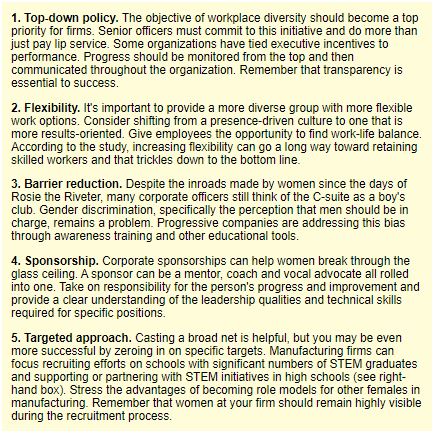The skills gap in manufacturing continues with industry observers, officials and employees saying much of the cause is a lack of women in high-level positions.
Women represent 47% of the overall U.S. labor force yet they comprise just 29% of the manufacturing sector, according to the Manufacturing Institute, an independent group that encourages hiring women in the sector.
Despite a recent industry resurgence, manufacturing still suffers from a lack of talent and a lag in the number of women in management. To help narrow the gap, the institute and others set up the Science, Technology, Engineering and Production (STEP) Ahead initiative. Among other things, the institute annually presents awards to honor women who have demonstrated excellence spanning all levels and areas of the industry from the plant floor to the C-suite of top corporate officers. You can find more information here.
Women Are Critical
A highly-skilled and flexible workforce is required to sustain growth momentum in the manufacturing sector. Women represent one of the largest pools of untapped talent for manufacturers. As a group, women:
- Hold more than half of the associate’s, bachelor’s and master’s degrees in the United States,
- Occupy more than half of the managerial and professional jobs nationwide, and
- Own almost half of the private companies in the country.
Over the next few years, hiring women is expected to become even more significant than designing new products and boosting market share. Research shows that diverse organizations are more profitable than those that aren’t diverse. Despite the fact that hiring more women has been demonstrated to be smart business, manufacturing has been slow to catch up with other sectors.
Five Strategies for Moving Forward
Attracting and retaining more women for skilled positions in manufacturing is easier said than done. The following five best practices, generally advocated by the Manufacturing Institute, may help:

The manufacturing industry has made great strides in this area in the past few decades, but there’s still plenty of room for growth. Firms must continue to fight against age-old biases and actively promote high-tech careers in the manufacturing sector to succeed in the 21st century.
Copyright © 2020
